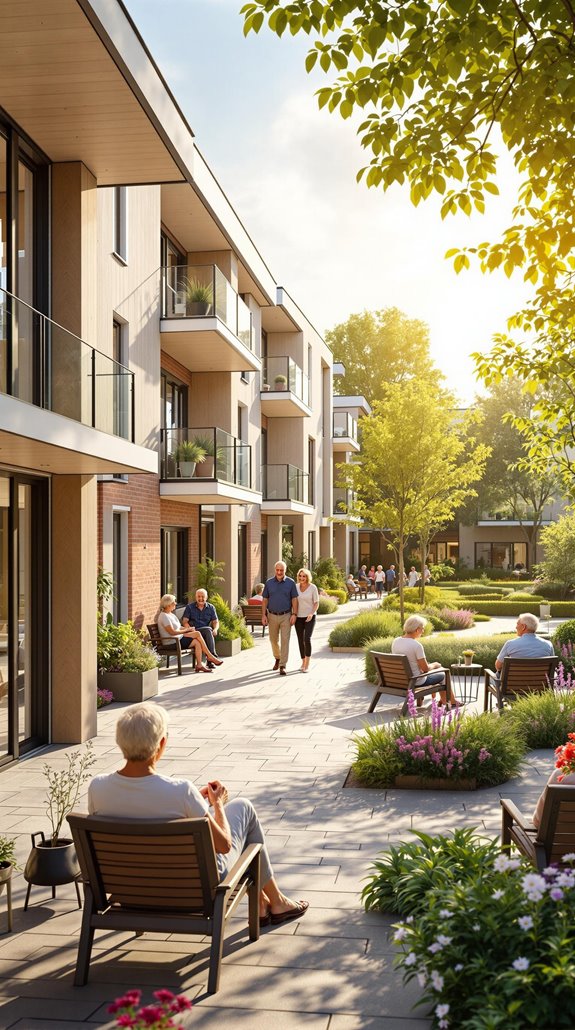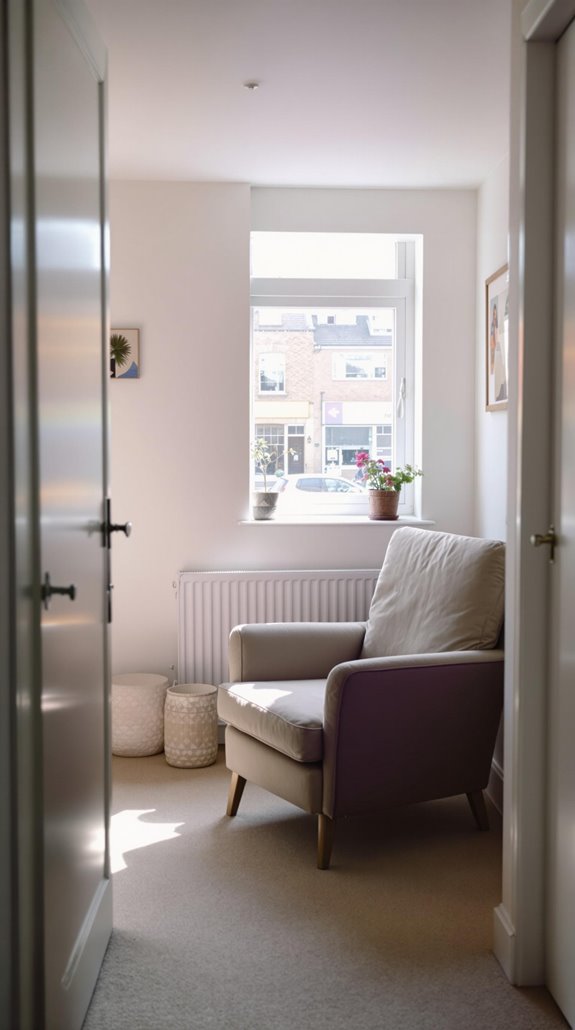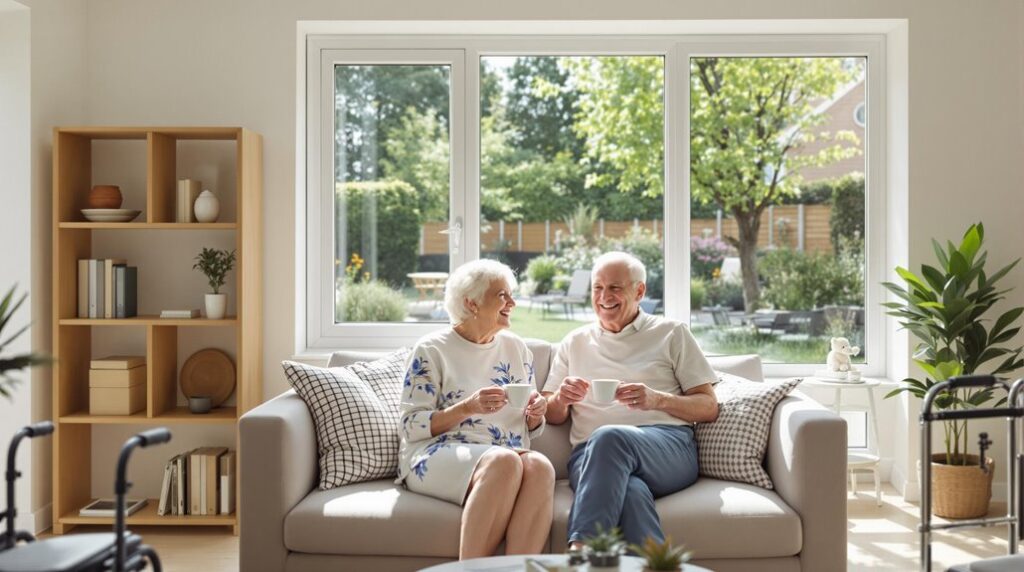I’ve been researching retirement flats across the UK, and I’ll be honest—the decision isn’t straightforward. You’re weighing significant lifestyle changes against substantial financial commitments, while factoring in everything from service charges to resale values. There’s compelling evidence on both sides that could influence your choice, but the real question isn’t whether retirement flats work in general. It’s whether they’ll work for your specific situation, and that depends on factors you might not have considered yet.
Key Takeaways
- Retirement flats reduce fall risk and provide emergency call systems, but many lack 24/7 medical support coverage.
- Properties cost 17% more than standard homes with annual service charges of £6,000-£8,000 that continue indefinitely.
- Communal activities and maintenance-free living reduce isolation, though resale markets are sluggish with limited buyer demand.
- Hidden exit fees and event fees around 1% of sale price can significantly reduce profits when selling.
- Financial planning is crucial as retirement properties often depreciate faster and sell at losses compared to standard homes.
Understanding Retirement Flats and Their Growing Appeal in the UK

The shift toward retirement flats represents one of the UK’s most significant housing transformations, driven by a rapidly aging population and evolving lifestyle preferences. I’ve watched this market evolve as over-55s increasingly choose purpose-built communities that prioritize independence over traditional care models.
These aren’t your typical apartments—they’re strategically designed with single-level layouts, step-free access, and emergency monitoring systems that let you maintain autonomy while staying connected to neighbors facing similar life changes. The 2024 leasehold reforms have strengthened your ownership rights with 990-year leases and transparent service charges. Additionally, many developers are incorporating open-plan layouts that enhance the sense of space and community.
What makes these developments particularly appealing is their focus on combating isolation through shared lounges, gardens, and organized activities. You’re joining a community where everyone understands the value of low-maintenance living without sacrificing social connection or security. Most properties feature wide doorways and hallways that accommodate mobility aids and wheelchairs, ensuring accessibility remains paramount as your needs evolve.
The Key Benefits of Moving to Retirement Housing
Moving beyond the fundamental appeal of retirement housing, you’ll discover measurable advantages that directly impact your daily life and long-term well-being. You’ll reduce your fall risk by 1.5–2.8 times through thoughtfully adapted properties, while emergency call systems in living and shower areas provide immediate assistance when needed. Additionally, conducting a thorough house survey before making a purchase can identify any potential issues that may affect your comfort and safety.
Your financial planning becomes more predictable with fixed service charges covering maintenance and utilities, plus potential housing benefit eligibility. You’ll eliminate individual home maintenance costs while retaining equity through ownership models.
The built-in companionship through communal dining and activities creates natural support networks, reducing isolation considerably. You’ll join a community where residents share similar interests and life stages, fostering genuine connections. These structured social opportunities elevate your lifestyle, with residents reporting higher happiness and activity levels than traditional housing arrangements. Most residents feel a strong sense of personal empowerment, with the majority believing they have more control over their lives compared to their previous living situations.
Potential Drawbacks and Challenges to Consider

While retirement housing offers compelling advantages, you’ll face significant financial and practical challenges that require careful evaluation before committing.
Your property will likely depreciate faster than standard homes, with limited resale demand often forcing sales below purchase prices. You’ll need 10-15 years of ownership just to see modest appreciation, creating negative equity risks that could drain your savings.
Service charges present another major burden, ranging from £6,000-£8,000 annually, with unpredictable increases when profit-driven companies acquire freeholds. Hidden exit fees can reach tens of thousands, while mandatory fund contributions continue even after death until your family sells the property.
You’ll also sacrifice living space and face potential medical care gaps, as most villages lack 24/7 clinical support despite marketing promises. The limited pool of buyers due to age restrictions makes selling particularly challenging, as younger buyers are excluded from purchasing these properties.
Financial Implications: Costs, Tenure Options, and Long-Term Value
Before you sign any retirement property contract, you’ll need to factor in costs that extend far beyond the initial purchase price. I’ve found that retirement properties typically cost 17% more than standard new builds in the same area—you’re paying for those spa facilities and transport services whether you use them or not.
Here’s what catches most buyers off-guard: ongoing service charges that continue accruing even when your property sits empty during resale. You’ll also face event fees (around 1% of sale price) that directly reduce your net proceeds. Most retirement properties come as leaseholds with 999-year terms, which protects your investment but limits your control. Additionally, it’s important to consider the typical costs involved when hiring a solicitor to navigate the legal aspects of your purchase.
The resale market can be sluggish—some properties take years to sell, making this a lifestyle choice rather than a financial investment. Additionally, subletting properties is not permitted in any of the retirement villages, which further restricts your options if you need to move but cannot sell immediately.
Comparing Traditional Retirement Housing Vs Integrated Retirement Communities
Beyond the financial considerations, you’ll need to choose between two fundamentally different retirement living models that’ll shape your daily experience and care options.
Traditional retirement housing offers age-restricted properties with minimal amenities, relying on external care providers when needed. You’ll get basic accommodation but limited social infrastructure or wellness facilities.
Integrated Retirement Communities (IRCs) provide a thorough approach. You’ll access on-site care teams, personalized support plans, and extensive amenities including restaurants, hobby rooms, and wellness suites. These communities foster social engagement through structured activities and communal spaces. Evidence suggests that residents in IRCs may experience decreased care needs over time, improving their overall quality of life.
The key difference lies in adaptability. Traditional housing often requires relocation when health declines, while IRCs enable aging in place with seamless care changes. IRCs also contribute positively to local housing markets, freeing up family-sized homes.
Regional Availability and Market Supply Considerations
When you’re ready to explore retirement housing options, you’ll quickly discover that your location dramatically impacts what’s available to you. Southeast England dominates the market—London offers 3.1% penetration while the South East reaches 6.1%. If you’re in Northern Ireland or Wales, you’re facing severe undersupply at just 0.2% and 1.6% respectively.
This geographic imbalance means you’ll have fewer choices outside affluent regions. Private-sector schemes concentrate where wealth clusters, leaving mid-market options scarce elsewhere. You might find yourself traveling farther for quality options—London buyers travel 76% more distance for Integrated Retirement Communities than typical new-build purchasers.
The pipeline shows promise with 58% of 2022’s new schemes being retirement housing, but current delivery rates won’t meet growing demand. The UK’s IRC market remains approximately 20 years behind the more mature US and Australian markets, indicating significant room for future development.
Making the Decision: Is Retirement Flat Living Right for Your Circumstances
The stark regional differences in retirement housing availability set the stage for a more fundamental question: whether retirement flat living actually fits your personal circumstances and financial situation. I’ll help you evaluate this decision through five critical factors.
First, assess your budget beyond the purchase price. Retirement flats average 17% higher costs than standard properties, plus ongoing service charges that can increase without notice. Additionally, consider the potential for hidden costs associated with renovations or modifications to your new home. Second, understand leasehold obligations—you’ll pay mandatory service charges that may continue after death until sale. Third, consider resale challenges: these properties often sell at a loss with high exit fees reaching tens of thousands. Fourth, weigh lifestyle benefits like communal facilities and maintenance-free living. These properties are designed exclusively for individuals aged 55 and above, often featuring additional support through on-site managers or wardens. Finally, scrutinize hidden costs and fee transparency before committing.
Conclusion
I’ve outlined the key factors you’ll need to evaluate when considering retirement flats. Now it’s time to crunch the numbers, assess your priorities, and map out your specific requirements. Create a comparison spreadsheet covering costs, amenities, and location preferences. Visit multiple properties, scrutinize service charge breakdowns, and consult with financial advisors. This systematic approach will help you make an informed decision that aligns with your lifestyle goals and budget constraints.
References
- https://www.knightfrank.co.uk/content-assets/701aedbea4c14f4a85b09654bb5f27fe/uk-seniors-housing-market-update-q1-2025-12187.pdf
- https://www.housinglin.org.uk/_assets/Resources/Housing/OtherOrganisation/jll-uk-seniors-housing-report-2024.pdf
- https://www.planradar.com/gb/building-retirement-properties/
- https://www.knightfrank.com/research/article/2025-05-28-uk-seniors-housing-market-update
- https://www.propertyinvestortoday.co.uk/breaking-news/2024/08/retirement-properties-with-a-tenant-in-situ-can-be-a-smart-investment/
- https://www.housinglin.org.uk/_assets/Resources/Housing/OtherOrganisation/Retirement Living Explained – PDF version1.pdf
- https://www.hortonandgarton.co.uk/blog/retirement-properties/
- https://www.ageuk.org.uk/siteassets/documents/factsheets/fs2_buying_retirement_housing_fcs.pdf
- https://www.mccarthyandstone.co.uk/articles-and-news/property-advice/what-is-a-retirement-property/
- https://santhemresidences.co.uk/retirement-apartment-or-retirement-bungalow/

